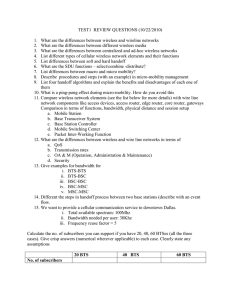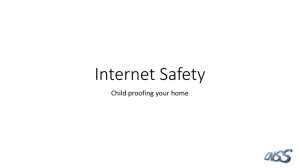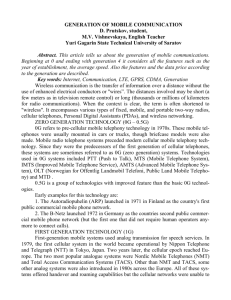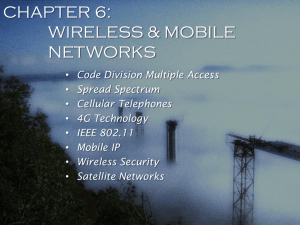Chapter 7
advertisement
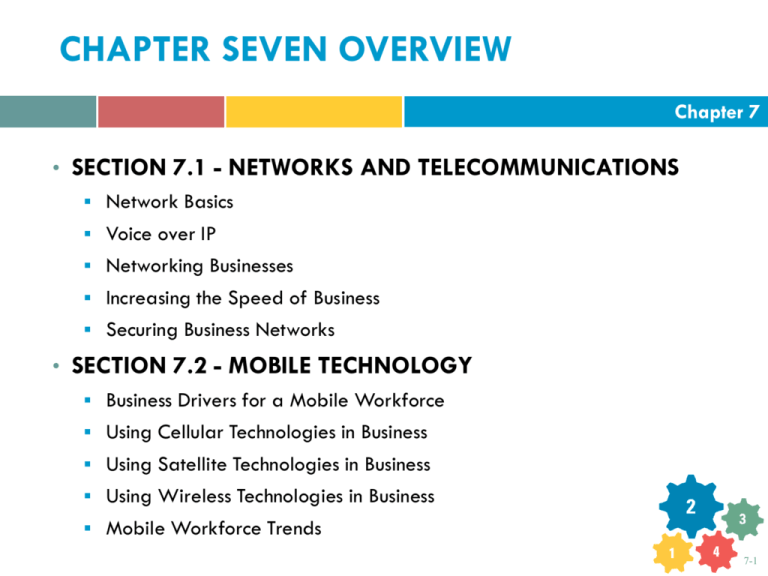
CHAPTER SEVEN OVERVIEW Chapter 7 • SECTION 7.1 - NETWORKS AND TELECOMMUNICATIONS Network Basics Voice over IP Networking Businesses Increasing the Speed of Business Securing Business Networks • SECTION 7.2 - MOBILE TECHNOLOGY Business Drivers for a Mobile Workforce Using Cellular Technologies in Business Using Satellite Technologies in Business Using Wireless Technologies in Business Mobile Workforce Trends 7-1 NETWORK BASICS Chapter 7 • Local area network (LAN) - is designed to connect a group of computers in close proximity to each other such as in an office building, a school, or a home. • Wide area network (WAN) - spans a large geographic area, such as a state, province, or country • Metropolitan area network (MAN) - a large computer network usually spanning a city 7-2 VOICE OVER IP (VoIP) Chapter 7 • Voice over IP (VoIP) - uses TCP/IP technology to transmit voice calls over long-distance telephone lines 7-3 NETWORKING BUSINESSES Chapter 7 • Virtual private network (VPN) - a way to use the public telecommunication infrastructure (e.g., Internet) to provide secure access to an organization’s network • Valued-added network (VAN) - a private network, provided by a third party, for exchanging information through a high capacity connection 7-4 INCREASING THE SPEED OF BUSINESS Chapter 7 7-5 SECURING BUSINESS NETWORKS Chapter 7 • An organization has to be concerned about… Proper identification of users and authorization of network access The control of access, and the protection of data integrity • Even more important than the sharing of technology resources is the sharing of data 7-6 BUSINESS DRIVERS FOR WIRELESS TECHNOLOGY Chapter 7 7-7 BUSINESS DRIVERS FOR A MOBILE WORKFORCE Chapter 7 7-8 USING CELLULAR TECHNOLOGIES IN BUSINESS Chapter 7 7-9 USING CELLULAR TECHNOLOGIES IN BUSINESS Chapter 7 • Personal digital assistants (PDA) are small, handheld computers capable of entirely digital communications transmission • Bluetooth – a telecommunications industry specification that describes how mobile phones, computers, and personal digital assistants (PDAs) can be easily interconnected using a short-range wireless connection 7-10 USING SATELLITE TECHNOLOGIES IN BUSINESS Chapter 7 • Satellite - a big microwave repeater in the sky; it contains one or more transponders that listen to a particular portion of the electromagnetic spectrum, amplifying incoming signals, and retransmitting them back to Earth • Microware transmitter - commonly used to transmit network signals over great distances 7-11 USING SATELLITE TECHNOLOGIES IN BUSINESS Chapter 7 • Location-based services (LBS) - are wireless mobile content services which provide location-specific information to mobile users moving from location to location • Global Positioning System (GPS) - is a "constellation" of 24 well-spaced satellites that orbit the Earth and make it possible for people with ground receivers to pinpoint their geographic location • Geographic information system (GIS) - is designed to work with information that can be shown on a map 7-12 USING WIRELESS TECHNOLOGIES IN BUSINESS Chapter 7 • Wireless fidelity (wi-fi) – a means of linking computers using infrared or radio signals WiMAX - is a telecommunications technology aimed at providing wireless data over long distances in a variety of ways, from point-to-point links to full mobile cellular type access Radio frequency identification (RFID) - use active or passive tags in the form of chips or smart labels that can store unique identifiers and relay this information to electronic readers 7-13 MOBILE WORKFORCE TRENDS Chapter 7 • Social networking gets mobilized • Mobile TV • Multi-function devices become cheaper and more • • • • • versatile Location-based services Mobile advertising Wireless providers move into home entertainment Wireless security moves to the forefront Enterprise mobility 7-14








